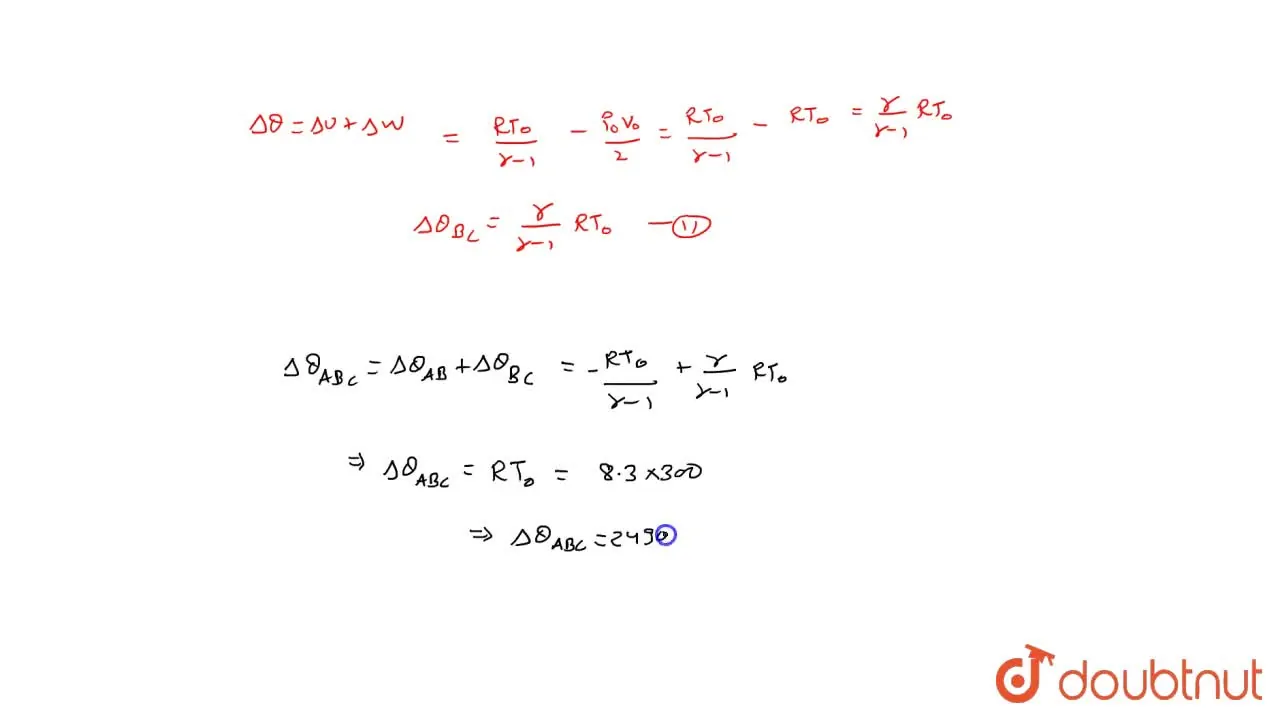Two moles of an ideal gas at temperature T0=300K was cooled isochorically so that the pressure was reduced to half. Then, in an isobaric process, the gas expanded till its temperature got back to the initial value. Find the total amount of heat absorbed by the gas in the processs
In an isochoric process, ΔW=0 (ΔV=0)
and ΔU=CVΔT=Rγ−1ΔT (∵Cv=Rγ−1)
⇒ΔU=Δ(RT)γ−1=Δ(pV)γ−1
=Vγ−1ΔP=Vγ−1(12P−P)=−11pV2γ−1
Now ΔQ=ΔU+ΔW
∴ΔQ=−12pVγ−1+0=−12pV2γ−1=12γRT−1
The negative sign shows that heat is not added but subtracted form the gas in the process
In the isobaric process
ΔW=∫VfVidV=P2(Vf−Vi) [ In this process pressure is P2]
In an isochroic process, V remain constant, so p∝T and temperature is reduced to T0/2
In the isobaric process, the original temperature is restored.
ΔT=T0−T0/2=T0/2
ΔUCvΔT=Rγ−1T02(∵CV=R(γ−1) and ΔT=T02)
∴ΔQ=ΔU+ΔW=12RTγ−1+12RT0
∴ Net heat added is
[−12RT0γ−1]+[12RT0γ−1+12RT0]=12RT0
This is the heat added when the number of moles is one.
When there are 2 moles, heat added is
2×227RT0=8.3×300=2490J
Related Playlists
- BOOK - CENGAGE PHYSICSCHAPTER - KINETIC THEORY OF GASES AND FIRST LAW OF THERMODYNAMICSEXERCISE - Solved Examples14videos
KINETIC THEORY OF GASES AND FIRST LAW OF THERMODYNAMICS
- BOOK - CENGAGE PHYSICSCHAPTER - KINETIC THEORY OF GASES AND FIRST LAW OF THERMODYNAMICSEXERCISE - Exercise 2.120videos
KINETIC THEORY OF GASES AND FIRST LAW OF THERMODYNAMICS
- BOOK - CENGAGE PHYSICSCHAPTER - KINETIC THEORY OF GASESEXERCISE - Compression2videos
KINETIC THEORY OF GASES
- BOOK - CENGAGE PHYSICSCHAPTER - LINEAR AND ANGULAR SIMPLE HARMONIC MOTIONEXERCISE - Multiple Correct Answer Type9videos
LINEAR AND ANGULAR SIMPLE HARMONIC MOTION
Similar Questions
Two moles of a certain ideal gas at temperature T0= 300 K were cooled isochorically so that the gas pressure reduced η= 2.0 times. Then, as a result of the isobaric process, the gas expanded till its temperature get back to the initial value. Find the total amount of heat absorbed by the gas in this process.
View SolutionTwo moles of a certain gas at a temperature T0=300K were cooled isochorically so that the pressure of the gas got reduced 2 times. Then as a result of isobaric process, the gas is allowed to expand till its temperature got back to the initial value. Find the total amount of heat absorbed by gas in this process.
View SolutionTwo moles of a certain ideal gas at 300K were cooled at constant volume so that the pressure was reduced to half t he initial value. Then, as a result of heating at constant pressure, the gas expanded till its temperature got back ot the initial value. Find the total amount of heat absorbed by the gas in the process.
View SolutionTwo moles of a certain ideal gas at 300K is cooled at constant volume so that the pressure is reduced to half the original value. Now the gas is heated at constant pressure so that its temperature becomes equal to the initial temperature. Find the total amount of heat absorbed by the gas in the process.
View SolutionOne mole of an ideal gas at temperature T was cooled isochorically till the gas pressure fell from P to Pn. Then, by an isobaric process, the gas was restored to the initial temperature. The net amount of heat absorbed by the gas in the process is
View SolutionSix grams of hydrogen gas at a temperature of 273 K isothoermally expanded to five times its initial volume and then isochorically heated so that the pressure in the final state becomes equal to that in the initial state. Find the total amount of heat absorbed by the gas during the entire process.
View SolutionThree moles of an ideal gas, initially at T0=273K isothermally expanded n=5 times its initial volume and then isochorically heated so that the pressure in the final state became equal to that in the initial state. The total quantity of heat transferred to the gas during the process was Q=80kJ. Represent the whole process in a pV diagram. Find the adiabatic exponent of the gas.
View SolutionTwo moles of an ideal gas are cooled isochorically and then expanded isobarically to lower the gas temperature back to the initial value. Find the entropy increment of the gas if in this process the gas pressure changed n=3.3 times.
View SolutionIn a cyclic process initially a gas is at 105 Pa pressure and its volume is 2m3. First it undergoes an isobaric expansion to increase its volume to 2.5m3. The in an isochoric process its pressure is doubled. Now the gas is brought back to its initial state by changing the pressure of gas linearly with its volume. Find the total amount of heat supplied to the gas in the process.
View SolutionThree moles of an ideal gas being initially at a temperature Ti=273K were isothermally expanded 5 times its initial volume and then isochorically heated so that the pressure in the final state becomes equal to that in the initial state. The total heat supplied in the process is 80kJ. Find γ(=CpCV) of the gas.
View Solution


